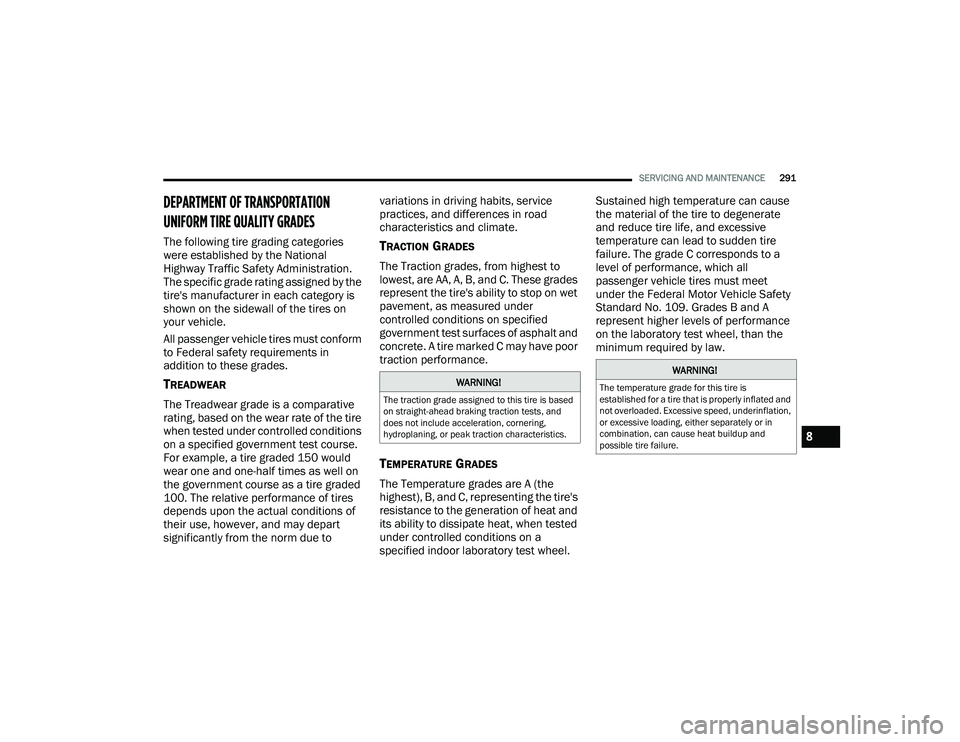2022 CHRYSLER VOYAGER maintenance plan
[x] Cancel search: maintenance planPage 7 of 316

5
SAFETY
SAFETY FEATURES .............................................. 158Anti-Lock Brake System (ABS) ..................... 158
Rear Seat Reminder Alert (RSRA) ................ 159
Electronic Brake Control (EBC) System ...... 159
AUXILIARY DRIVING SYSTEMS .......................... 164
Blind Spot Monitoring (BSM) —
If Equipped..................................................... 164
Forward Collision Warning (FCW) With
Mitigation — If Equipped ............................... 168
Tire Pressure Monitoring System
(TPMS)............................................................ 171
OCCUPANT RESTRAINT SYSTEMS .................... 174
Occupant Restraint Systems Features ....... 174Important Safety Precautions....................... 174
Seat Belt Systems ........................................ 175
Supplemental Restraint Systems (SRS) ...... 184
Child Restraints ........................................... 197
SAFETY TIPS ......................................................213
Transporting Passengers .............................. 213Transporting Pets ....................................... 214
Safety Checks You Should Make
Inside The Vehicle ........................................ 214
Periodic Safety Checks You Should Make
Outside The Vehicle ...................................... 215Exhaust Gas ................................................... 216Carbon Monoxide Warnings ......................... 216
IN CASE OF EMERGENCY
HAZARD WARNING FLASHERS......................... 217
ASSIST AND SOS MIRROR — IF EQUIPPED ..... 217
JACKING AND TIRE CHANGING —
IF EQUIPPED ..................................................... 220 Preparations For Jacking ............................. 221
Jack And Spare Tire Location ....................... 221
Equipment Removal ..................................... 221
Jacking Instructions .................................... 223
Road Tire Installation .................................... 226
Portable Air Compressor —
If Equipped..................................................... 227Return Inflatable Spare Tire ....................... 228
TIRE SERVICE KIT — IF EQUIPPED .................... 228
JUMP STARTING .................................................. 234 Preparations For Jump Start ........................ 234
Jump Starting Procedure .............................. 235
REFUELING IN EMERGENCY –
IF EQUIPPED ....................................................... 236
IF YOUR ENGINE OVERHEATS ........................... 237
MANUAL PARK RELEASE .................................. 238
FREEING A STUCK VEHICLE .............................. 239
TOWING A DISABLED VEHICLE ......................... 240
ENHANCED ACCIDENT RESPONSE SYSTEM
(EARS) .................................................................. 242
EVENT DATA RECORDER (EDR) ........................ 242
SERVICING AND MAINTENANCE
SCHEDULED SERVICING ..................................... 243
Maintenance Plan ......................................... 244
ENGINE COMPARTMENT .................................... 247
3.6L Engine ................................................... 247
Checking Oil Level ......................................... 248
Adding Washer Fluid .................................... 248
Maintenance-Free Battery ........................... 248
Pressure Washing ......................................... 249
VEHICLE MAINTENANCE ..................................... 249
Engine Oil ...................................................... 249
Engine Oil Filter ........................................... 250
Engine Air Cleaner Filter ............................ 250
Accessory Drive Belt Inspection ................... 250Air Conditioner Maintenance ....................... 251
Body Lubrication ........................................... 253
Windshield Wiper Blades ............................. 253Exhaust System ............................................ 256
Cooling System.............................................. 258
Brake System ................................................ 261
Automatic Transmission .............................. 262
Fuses.............................................................. 263
Bulb Replacement ........................................ 272
22_RUVG_OM_EN_USC_t.book Page 5
Page 246 of 316

244SERVICING AND MAINTENANCE
MAINTENANCE PLAN
Refer to the Maintenance Plan for required maintenance.
At Every Oil Change Interval As Indicated By Oil Change Indicator System:
Change oil and filter.
Rotate the tires at the first sign of irregular wear, even if it occurs before the oil indicator system turns on.
Inspect battery and clean and tighten terminals as required.
Inspect the CV/Universal joints.
Inspect brake pads, shoes, rotors, drums, hoses and parking brake.
Inspect engine cooling system protection and hoses.
Inspect exhaust system.
Inspect engine air cleaner filter if using in dusty or off-road conditions. If required, replace engine air cleaner filter.
22_RUVG_OM_EN_USC_t.book Page 244
Page 293 of 316

SERVICING AND MAINTENANCE291
DEPARTMENT OF TRANSPORTATION
UNIFORM TIRE QUALITY GRADES
The following tire grading categories
were established by the National
Highway Traffic Safety Administration.
The specific grade rating assigned by the
tire's manufacturer in each category is
shown on the sidewall of the tires on
your vehicle.
All passenger vehicle tires must conform
to Federal safety requirements in
addition to these grades.
TREADWEAR
The Treadwear grade is a comparative
rating, based on the wear rate of the tire
when tested under controlled conditions
on a specified government test course.
For example, a tire graded 150 would
wear one and one-half times as well on
the government course as a tire graded
100. The relative performance of tires
depends upon the actual conditions of
their use, however, and may depart
significantly from the norm due to variations in driving habits, service
practices, and differences in road
characteristics and climate.
TRACTION GRADES
The Traction grades, from highest to
lowest, are AA, A, B, and C. These grades
represent the tire's ability to stop on wet
pavement, as measured under
controlled conditions on specified
government test surfaces of asphalt and
concrete. A tire marked C may have poor
traction performance.
TEMPERATURE GRADES
The Temperature grades are A (the
highest), B, and C, representing the tire's
resistance to the generation of heat and
its ability to dissipate heat, when tested
under controlled conditions on a
specified indoor laboratory test wheel.Sustained high temperature can cause
the material of the tire to degenerate
and reduce tire life, and excessive
temperature can lead to sudden tire
failure. The grade C corresponds to a
level of performance, which all
passenger vehicle tires must meet
under the Federal Motor Vehicle Safety
Standard No. 109. Grades B and A
represent higher levels of performance
on the laboratory test wheel, than the
minimum required by law.
WARNING!
The traction grade assigned to this tire is based
on straight-ahead braking traction tests, and
does not include acceleration, cornering,
hydroplaning, or peak traction characteristics.
WARNING!
The temperature grade for this tire is
established for a tire that is properly inflated and
not overloaded. Excessive speed, underinflation,
or excessive loading, either separately or in
combination, can cause heat buildup and
possible tire failure.
8
22_RUVG_OM_EN_USC_t.book Page 291